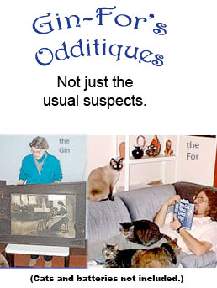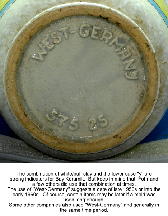
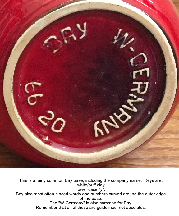 Bay Keramik: Started by Eduard Bay in 1933; note that it's not correct that Bay stopped art pottery production in 1971; some art production continued into the 1980s, including some striking works....and some not so striking.
Bay's best known designer was Bodo Mans, and it's common for many items to be attributed to him just because the name is known, but be sure those attributions are documented, not simply assumed.
Bay was one of the largest producers and made some very good designs. They also made some rare specialty glazes that are utterly fantastic. However, they also produced a huge amount of kitsch, tourist ware and designs of questionable aesthetic value.
Bay Keramik: Started by Eduard Bay in 1933; note that it's not correct that Bay stopped art pottery production in 1971; some art production continued into the 1980s, including some striking works....and some not so striking.
Bay's best known designer was Bodo Mans, and it's common for many items to be attributed to him just because the name is known, but be sure those attributions are documented, not simply assumed.
Bay was one of the largest producers and made some very good designs. They also made some rare specialty glazes that are utterly fantastic. However, they also produced a huge amount of kitsch, tourist ware and designs of questionable aesthetic value.
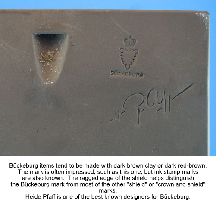 Bückeburg:
Bückeburg:
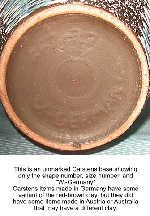
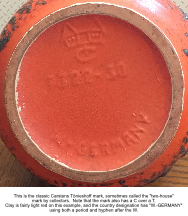
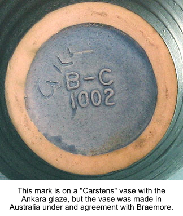 Carstens: The Carstens Tönnieshof factory started in the 1950s and focused on a high quality product. Production numbers were fairly high, but there were special lines and glazes done in much smaller numbers. Most items have red-brown clay, but some made in Austria or Australia used a different clay.
Carstens: The Carstens Tönnieshof factory started in the 1950s and focused on a high quality product. Production numbers were fairly high, but there were special lines and glazes done in much smaller numbers. Most items have red-brown clay, but some made in Austria or Australia used a different clay.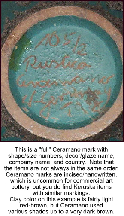
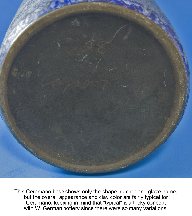
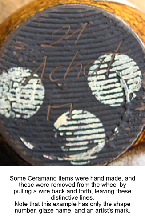 Ceramano: (1959-84) Ceramano was started by Jakob Schwaderlapp, who also ran Jasba, to be a higher-end company, more like a studio than most commercial art potteries. Quality was high and production numbers relatively low. While the production from most commercial potteries is all moulded (although often with hand work in the decoration), Ceramano did both molded and hand-made pots.
Designers included Gerda Heuckenroth and Hanns Welling.
Top decors include Pergamon, Rustica, and Rubin plus rarities such as Saturn. Many of the more subtle glazes remain under-rated. Clay color ranges from light brown to very dark brown.
Ceramano: (1959-84) Ceramano was started by Jakob Schwaderlapp, who also ran Jasba, to be a higher-end company, more like a studio than most commercial art potteries. Quality was high and production numbers relatively low. While the production from most commercial potteries is all moulded (although often with hand work in the decoration), Ceramano did both molded and hand-made pots.
Designers included Gerda Heuckenroth and Hanns Welling.
Top decors include Pergamon, Rustica, and Rubin plus rarities such as Saturn. Many of the more subtle glazes remain under-rated. Clay color ranges from light brown to very dark brown.
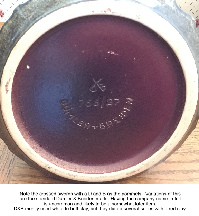
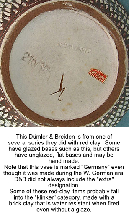
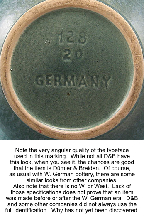
 Dümler & Breiden: (1883-1992)
D&B was one of the many companies in the Höhr-Grenzhausen region, and they produced an enormous range of styles over the years, from very traditional to strong Pop Art.
Dümler & Breiden: (1883-1992)
D&B was one of the many companies in the Höhr-Grenzhausen region, and they produced an enormous range of styles over the years, from very traditional to strong Pop Art.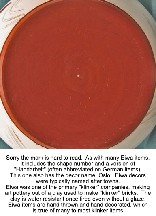 Eiwa:
Eiwa:
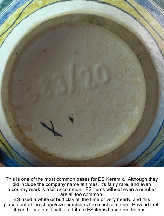
ES Keramik:
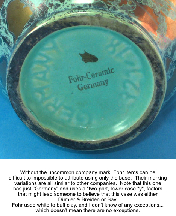 Fohr:
Fohr:
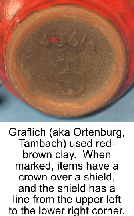 Gräflich: Graflich items are not as well known or as numerous as some of the best known companies, but they made some lovely jewel tone glazes and an interesting volcanic variant where the volcanic glaze is the underglaze, bubbling through in patches.
Gräflich: Graflich items are not as well known or as numerous as some of the best known companies, but they made some lovely jewel tone glazes and an interesting volcanic variant where the volcanic glaze is the underglaze, bubbling through in patches.
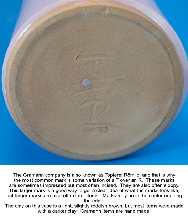
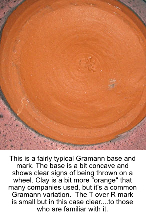
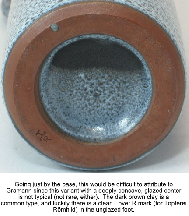
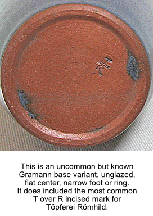 Gramann (Topferei Römhild): Gramann, also known as Töpferei Römhild was an East German company. Most works are hand made and feature some of the earliest volcanic glazes for the era.
Gramann (Topferei Römhild): Gramann, also known as Töpferei Römhild was an East German company. Most works are hand made and feature some of the earliest volcanic glazes for the era.
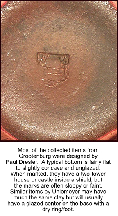 Grootenburg (Paul Dresler):
Grootenburg (Paul Dresler):
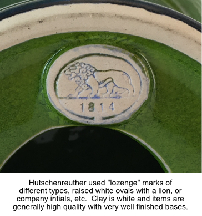
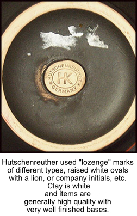 Hutschenreuther:
Hutschenreuther:
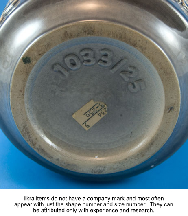 Ilkra:
Ilkra:
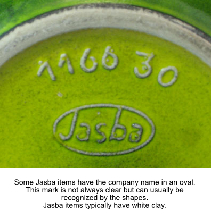
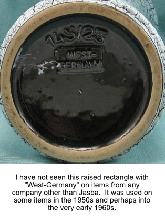
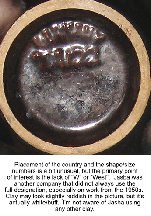 Jasba: (1926-current)
Started by Jakob Schwaderlapp and located in Baumbach. Well-known early decors include Cortina and Jaspatina, but the company produced a wide variety of styles, especially in the 60s. Economics forced them to stop significant art pottery production in the early 70s and survive on more utilitarian items. They also produced their share of tourist and kitsch items during their art pottery years.
The name comes from Ja (Jakob), S (Schwaderlapp), and Ba (Baumbach).
Jasba: (1926-current)
Started by Jakob Schwaderlapp and located in Baumbach. Well-known early decors include Cortina and Jaspatina, but the company produced a wide variety of styles, especially in the 60s. Economics forced them to stop significant art pottery production in the early 70s and survive on more utilitarian items. They also produced their share of tourist and kitsch items during their art pottery years.
The name comes from Ja (Jakob), S (Schwaderlapp), and Ba (Baumbach).
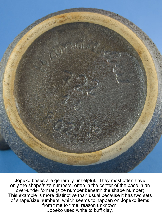 Jopeko:
Jopeko:
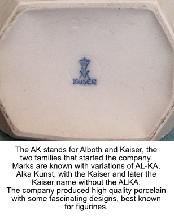 Kaiser (Alka Kunst):
Kaiser (Alka Kunst):
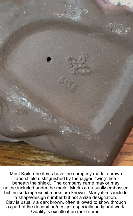 Karlsruhe:
Karlsruhe:
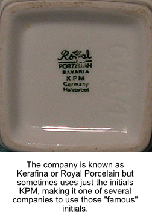 Kerafina (Royal Porzellan):
Kerafina (Royal Porzellan):
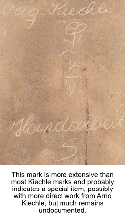 Kiechle: Kiechle items include extensive hand work and are among the highest quality in this "engobe" style. Not surprisingly, they are also hard to find with vases generally harder to find than plaques and plates. (Keto items are often similar but generally a step down in quality, but there are definitely exceptions as Keto did some very striking designs.)
Kiechle: Kiechle items include extensive hand work and are among the highest quality in this "engobe" style. Not surprisingly, they are also hard to find with vases generally harder to find than plaques and plates. (Keto items are often similar but generally a step down in quality, but there are definitely exceptions as Keto did some very striking designs.)
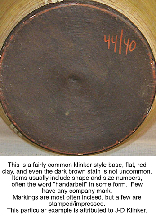 klinker: "Klinker" items are made from a particular clay, one that is typically used for a type of brick called klinkers. When fired, the clay becomes water resistant even without a glaze. Klinker items are often hand made and hand decoration. Decoration usually involves staining rather than glazing with part of the design created by cutting through to reveal the clay, but keep in mind that not all red or red-orange clays are "klinker". At one time, only a few klinker companies were documented, but many more are now known. Quite a few did only klinker items, but Dümler & Breiden and Ü-Keramik are among the major art pottery producers who branched out to do some klinker items as well. Other major klinker producers include AKRU, Eckhart & Engler, Eiwa, Gerz, Ilkra, J-D Keramik, Kule, Sawa, Siershahn, and Ernst Speier (SP, Hillscheid)
klinker: "Klinker" items are made from a particular clay, one that is typically used for a type of brick called klinkers. When fired, the clay becomes water resistant even without a glaze. Klinker items are often hand made and hand decoration. Decoration usually involves staining rather than glazing with part of the design created by cutting through to reveal the clay, but keep in mind that not all red or red-orange clays are "klinker". At one time, only a few klinker companies were documented, but many more are now known. Quite a few did only klinker items, but Dümler & Breiden and Ü-Keramik are among the major art pottery producers who branched out to do some klinker items as well. Other major klinker producers include AKRU, Eckhart & Engler, Eiwa, Gerz, Ilkra, J-D Keramik, Kule, Sawa, Siershahn, and Ernst Speier (SP, Hillscheid)
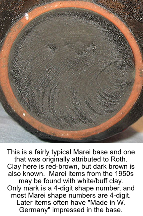 Marei: At one time, Marei was thought to be a fairly small company that peaked in the 1950s. However, better research revealed that they were a major company that did some of the best work of the 1960s and 70s. Be aware that many Marei items are still incorrectly attributed to Roth (and that company is a much smaller factor than once believed).
Marei: At one time, Marei was thought to be a fairly small company that peaked in the 1950s. However, better research revealed that they were a major company that did some of the best work of the 1960s and 70s. Be aware that many Marei items are still incorrectly attributed to Roth (and that company is a much smaller factor than once believed).
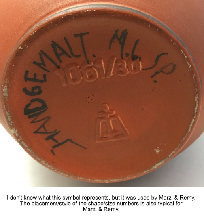
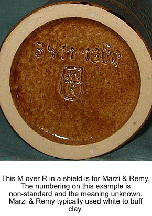 Marzi & Remy: Marzi & Remy items cover a full range from
traditional to "mid-century", including steins (for which they remain better known than their art pottery). Clay color ranges from white to red/brown. M&R is so variable that it can be one of the most difficult to attribute when not marked.
Marzi & Remy: Marzi & Remy items cover a full range from
traditional to "mid-century", including steins (for which they remain better known than their art pottery). Clay color ranges from white to red/brown. M&R is so variable that it can be one of the most difficult to attribute when not marked.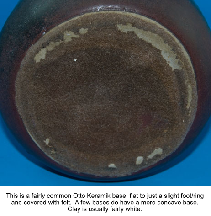
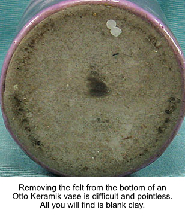 Otto Keramik: (1964-current) Otto Gerharz was a glaze genius not yet fully appreciated. His volcanic glazes are getting a lot of attention, but many of the non-volcanic glazes have great sutlety and complexity as well as often being more uncommon. Kurt Tschörner may have done some of the shape designs, but I have not seen documentation on that. Operation of the company was taken over by Otto Gerharz Jr., and the company remains in business. In addition to new forms and glazes, they have also released contemporary versions of some older glazes, generally less refined than the originals, and they have been reproducing the Ruscha bull and some other early shapes for several years. The later versions can usually be distinguished by the glaze.
Otto Keramik: (1964-current) Otto Gerharz was a glaze genius not yet fully appreciated. His volcanic glazes are getting a lot of attention, but many of the non-volcanic glazes have great sutlety and complexity as well as often being more uncommon. Kurt Tschörner may have done some of the shape designs, but I have not seen documentation on that. Operation of the company was taken over by Otto Gerharz Jr., and the company remains in business. In addition to new forms and glazes, they have also released contemporary versions of some older glazes, generally less refined than the originals, and they have been reproducing the Ruscha bull and some other early shapes for several years. The later versions can usually be distinguished by the glaze.
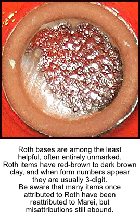 Roth:
Roth:
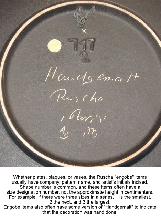
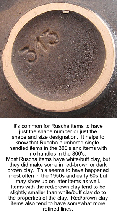 Ruscha: (1948-1996, name now owned by Scheurich)
Most of the best designers worked at Ruscha at one time or another, including Kurt Tschörner, Otto Gerharz, Hanns Welling, and Adele Bölz. They were among the top producers for both vases and wall items, although they did produce some mediocre work as well, particularly some of the later wall plaques.
Ruscha: (1948-1996, name now owned by Scheurich)
Most of the best designers worked at Ruscha at one time or another, including Kurt Tschörner, Otto Gerharz, Hanns Welling, and Adele Bölz. They were among the top producers for both vases and wall items, although they did produce some mediocre work as well, particularly some of the later wall plaques.
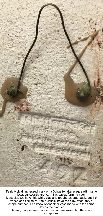 Schaeffenacker:
Schaeffenacker:
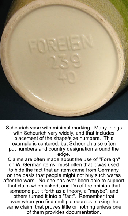
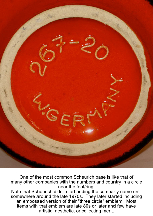 Scheurich: (1954-current)
Although the started late, Scheurich produced more items from the 1960s through the 1980s than any of the other art pottery companies. As usual, high production numbers means a wide range of quality and quality control, but some items, especially glazes are major achievements.
Note: the embossed three circle mark was used 1990-2004, so such items are not from the most collectible era. Scheurich used white/buff clay, but the foot is sometimes stained slightly by the glaze, making it look light red/brown.
Scheurich: (1954-current)
Although the started late, Scheurich produced more items from the 1960s through the 1980s than any of the other art pottery companies. As usual, high production numbers means a wide range of quality and quality control, but some items, especially glazes are major achievements.
Note: the embossed three circle mark was used 1990-2004, so such items are not from the most collectible era. Scheurich used white/buff clay, but the foot is sometimes stained slightly by the glaze, making it look light red/brown.
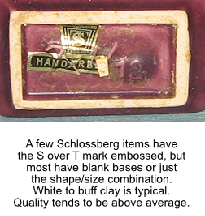
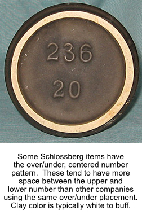 Schlossberg: (1946-1975)
These items are generally higher quality and harder to find, often difficult to attribute.
Schlossberg: (1946-1975)
These items are generally higher quality and harder to find, often difficult to attribute.
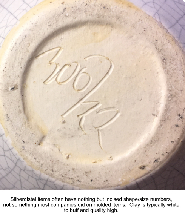
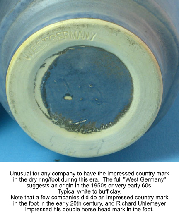 Silberdistel:
Silberdistel:
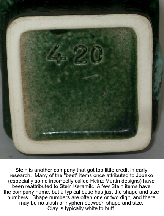 Stein:
Stein:
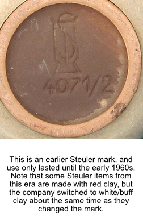
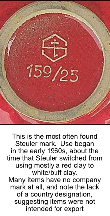 Steuler:
Steuler:
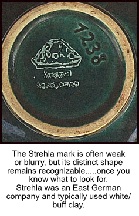 Strehla:
Strehla:
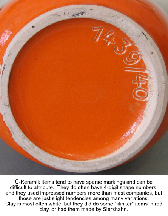 Ü-Keramik (Übelacker):
Ü-Keramik (Übelacker):
| Home | Videos/Essays | Blog |
